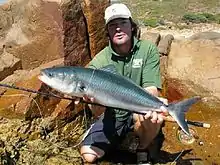| Black marlin | |
|---|---|
 | |
| Scientific classification | |
| Domain: | Eukaryota |
| Kingdom: | Animalia |
| Phylum: | Chordata |
| Class: | Actinopterygii |
| Order: | Istiophoriformes |
| Family: | Istiophoridae |
| Genus: | Istiompax Whitley, 1931 |
| Species: | I. indica |
| Binomial name | |
| Istiompax indica (G. Cuvier, 1832) | |
| Synonyms | |
|
List
| |
The black marlin (Istiompax indica) is a species of marlin found in tropical and subtropical areas of the Indian and Pacific Oceans.[2] Reaching lengths of over 4.5 m (15 ft),[2] it is one of the largest marlins and also one of the largest bony fish. Marlin are among the fastest fish, but speeds may be exaggerated in popular media, such as reports of 132 km/h (82 mph).[3] A 2016 study estimated maximum swimming speeds from muscle contraction times, which in turn limit the tail-beat frequency; the study suggested a theoretical upper limit for the black marlin's burst speed of 36 kilometres per hour (22 mph).[4] Black marlin are fished commercially and are also a highly prized game fish. Black marlins have been known to drag Maldivian fishing boats of the ancient times for very long distances until it got tired; and then it would take many hours for the fishermen to row or sail back home.[5]
Taxonomy
French naturalist Georges Cuvier described the black marlin in 1832 as Tetrapturus indicus.
Description
Compared to striped or white marlins and sailfish, black marlins are more solid than their blue counterparts. They have a shorter bill and a rounder and lower dorsal fin. Black marlin may be distinguished from all other marlin species by their rigid pectoral fins, which, especially from a weight of around 68 kg (150 lb), are unable to be pressed flat against their sides but can be tilted further backwards for reduced drag. The maximum published length is 4.65 m (15 ft 3 in), and the maximum weight is 750 kg (1,650 lb), possibly up to 900 kg (2,000 lb).[6][7]
Distribution
The species occurs in the tropical and subtropical Indo-Pacific, with uncommon movements into temperate waters, and rare reports from the Atlantic.[2]
Diet
Diet mostly consists of various fish and cephalopods. They may eat tuna, mackerel, snake mackerel, flying fish, squid, crustaceans, octopus, etc.[2]
See also
References
- ↑ Collette, B.B.; Di Natale, A.; Fox, W.; Juan Jorda, M.; Pohlot, B.; Schratwieser, J.; Graves, J. (2022). "Istiompax indica". IUCN Red List of Threatened Species. 2022: e.T170312A46646193. doi:10.2305/IUCN.UK.2022-1.RLTS.T170312A46646193.en. Retrieved 19 June 2023.
- 1 2 3 4 Froese, Rainer; Pauly, Daniel (eds.) (2013). "Istiompax indica" in FishBase. April 2013 version.
- ↑ BBC Worldwide (27-05-2008). Black marlin - the fastest fish on the planet. Ultimate Killers - BBC wildlife.
- ↑ Svendsen, Morten B. S.; Domenici, Paolo; Marras, Stefano; Krause, Jens; Boswell, Kevin M.; Rodriguez-Pinto, Ivan; Wilson, Alexander D. M.; Kurvers, Ralf H. J. M.; Viblanc, Paul E.; Finger, Jean S.; Steffensen, John F. (15 October 2016). "Maximum swimming speeds of sailfish and three other large marine predatory fish species based on muscle contraction time and stride length: a myth revisited". Biology Open. 5 (10): 1415–1419. doi:10.1242/bio.019919. ISSN 2046-6390. PMC 5087677. PMID 27543056.
- ↑ Romero-Frías, Xavier (2003). The Maldive Islanders : a study of the popular culture of an ancient ocean kingdom. Nova Ethnographia Indica. ISBN 84-7254-801-5. OCLC 55679148.
- ↑ "Istiompax indica, Black marlin : fisheries, gamefish". www.fishbase.se.
- ↑ Flindt, Rainer (21 December 2006). Amazing Numbers in Biology. Springer Science & Business Media. p. 12. ISBN 978-3-540-30147-9.
- Tony Ayling & Geoffrey Cox, Collins Guide to the Sea Fishes of New Zealand, (William Collins Publishers Ltd., Auckland, New Zealand 1982) ISBN 0-00-216987-8


